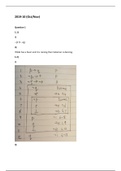2019-10 (Oct/Nov)
Question 1
1.1)
i)
¬(r→ ¬q)
ii)
If Bob has a fever and it is raining then Solomon is dancing.
1.2)
i)
ii)
,1.3)
Sequent is valid since in all critical rows (rows where all sequences is true) the conclusion is
also true.
1.4)
Step 1:
,Step 2:
Step 2:
Step 2:
Step 3:
Contradiction is marked, thus Horn formula is not satisfiable.
Question 2
2.1)
i)
There is a teacher who bores all the other teachers. OR
All teachers are bored by a certain teacher.
ii)
∀x∀y∀z ( T(y) ᴧ B(x,y) → B(y,z) )
X: objects, y:teacher, z:students
2.2)
Note you also have to take into account the information given like Q, S and P are
predicates with 2 variables.
i) Yes, It is well-formed Because a well formed formula can have free variables.
ii) No, because you can’t have a predicate inside the bracket.
iii) No, because you can’t have a constant with a quantifier
iv) No, because you must have a predicate symbol outside the bracket.
v) Yes, it is well formed.
2.3)
i) + ii)
,iii)
This question asks us can we replace free occurring y’s with f(x).
No, because f(x) is not free for y in Φ, since f(x) becomes bound upon introduction.
2.4)
,2.5)
i)
A = set of natural numbers
𝑅 𝑀 = R(a,b) such that a ≠ b (values are not equal)
It works, because if you apply my model to the WWF then it says that if you pick 2 natural
numbers such that the 1st value is not equal to the other one OR the 2nd one is not equal to
the 1st one then the 1st value will be equal to itself which is true. ¬R(x,x) says that 1st
value will be equal to itself which is true
ii)
A = set of natural numbers
𝑅 𝑀 = R(a,b) such that a = b (1st value is equal to the other value)
It falsifies it, because my models states that if you pick two natural numbers that such that
the 1st one is equal to the 2nd one OR that the 2nd number is equal to the 1st one then it will
be true that the 1st number will not be equal to itself, which is false.
,e.g. x=4, y =4. : 4≠4 is false
Question 3
3.1)
i)
It holds.
X1 points to a world and then that world points to another world containing p. Is this true
for at least one case. Yes it is true since x1 points to x2 and x2 points to x3 which contains a
p. Thus it holds.
ii)
It holds.
The statements asks us: Does x2 point to at least one world containing a ‘p’ AND does x2
point to all worlds containing a q? Yes this holds.
iii)
It holds.
If x3 contains ‘q’ then it must also contain a ‘p’. This is true because it contains a ‘p’ and a
‘q’.
iv)
It holds.
All the worlds that x4 is pointing to. Does all those worlds point to worlds that does not
contain a p? This holds, because x4 does not point to any worlds.
3.2)
i)
This would be valid, because the scheme would read
If p holds always in the future then always in the future p will always hold in the future. This
will hold.
ii)
The scheme would read:
If sometimes in the future p will not hold then p will not hold.
, 3.3) *Ask
i)
Change it using the rule:
If it is necessarily true that John takes an umbrella then it is necessarily true that the
weather isn’t bad
ii)
q ᴧ ♢p
¬ → ↔ ᴧ ☐ Φ ♢ ∀∃
3.4)
i)
¬𝐾2 𝐾1 q ᴧ 𝐾1 𝐾2 p
ii)
Agent 1 does not know q, Agent 2 does not know q or Agent 3 does not know q.
Better version:
Agent 1, nor Agent 2, nor Agent 3 does not know q.
3.5)




